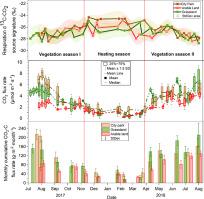Urban Climate ( IF 6.4 ) Pub Date : 2021-08-17 , DOI: 10.1016/j.uclim.2021.100949 Yaroslav Bezyk 1 , Izabela Sówka 1 , Maciej Górka 2

|
Understanding combinations of biogenic and anthropogenic inputs, and dynamics of carbon dioxide (CO2) fluxes in the urban environment is critical to investigate feedback between carbon cycle and climate system. The main objectives of this study are to analyse the role and interactions of anthropogenic and biogenic CO2 emission sources and sinks in the total carbon cycle within city limits, determine processes controlling urban ecosystem-atmosphere gas exchange under varying environmental conditions with a high temporal and spatial resolution.
The research addressing this issue was carried out in Wroclaw, the fourth largest city in Poland, throughout the year from July 2017 to August 2018. Chamber measurements of surface-atmosphere CO2 and CO2 net fluxes across various types of land cover (grassland, city park and arable land) provided the basis for assessing biogenic component of the urban C budget. In particular, the approach applied Picarro CRDS (cavity ring-down spectroscopy) technique with model G2201-I. Anthropogenic C fluxes were reported based on local statistical datasets and existing emission inventories, as well as the Low Emission Economy Plan from the Wroclaw urban area.
The findings showed that biogenic fluxes, over the course of one year, accounted for about 16.3% (RESP = 0.68 Mton CO2·yr−1) of the total city carbon emissions for Wroclaw, being entirely compensated by local vegetation C uptake (GEE = −0.89 Mt. CO2·yr−1). Compared to fluxes given by the previously reported emission inventory, the net biogenic CO2 sink (NEE) of 0.201 Mt. CO2·yr−1 was substantially greater, which indicates that the biosphere in Wroclaw is a net biogenic C sink. The average annual C budget in Wroclaw, obtained from the investigation of sectoral emission trends including those related to energy, road traffic, industrial processes, and other fluxes (human respiration), reaches about 3.87 kg C·m−2·yr−1.
中文翻译:

城市二氧化碳预算评估:人为和生物输入
了解生物和人为输入的组合以及城市环境中二氧化碳 (CO 2 ) 通量的动态对于研究碳循环和气候系统之间的反馈至关重要。本研究的主要目标是分析人为和生物 CO 2排放源和汇在城市范围内总碳循环中的作用和相互作用,确定在不同环境条件下控制城市生态系统 - 大气气体交换的过程,具有高时间和空间分辨率。
解决这一问题的研究是在弗罗茨瓦夫,在波兰第四大城市,从2017年7月开展,全年2018八月商会地表-大气二氧化碳的测量2和CO 2跨各类土地覆盖(草原网通量,城市公园和耕地)为评估城市 C 预算的生物成分提供了基础。特别是,该方法将 Picarro CRDS(腔衰荡光谱)技术应用于 G2201-I 型。人为碳通量是根据当地统计数据集和现有排放清单以及弗罗茨瓦夫市区的低排放经济计划报告的。
研究结果表明,在一年的过程中,生物源通量约占弗罗茨瓦夫城市碳排放总量的16.3% (RESP = 0.68 Mton CO 2 ·yr -1 ),完全由当地植被碳吸收 (GEE = -0.89 Mt.CO 2 ·yr -1 )。与先前报告的排放清单给出的通量相比,净生物源 CO 2汇 (NEE) 为 0.201 Mt. CO 2 ·yr -1大得多,这表明弗罗茨瓦夫的生物圈是一个净生物 C 汇。通过调查与能源、道路交通、工业过程和其他通量(人类呼吸)相关的部门排放趋势,弗罗茨瓦夫的年平均碳预算达到约 3.87 kg C·m -2 ·yr -1。



























 京公网安备 11010802027423号
京公网安备 11010802027423号